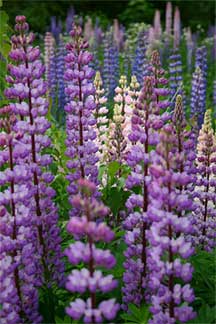The splendid hybrid lupines which we now enjoy, were developed, apparently, from just a few lupinus species. In a genus with hundreds of species, it is surprising that such a small number of species have found their way into our gardens and that only a few have been drawn upon in the creation of the modern hybrids.
About the ancestors of the brilliant new strains one cannot be certain, but it is generally thought that the western American herbaceous species, Lupinus polyphyllus, is the principal parent. If acquainted with the typical deep blue-flowered L. polyphyllus and the old-time blue and white forms, one will know without being told that something else was added to the strain to obtain the colors now available.

It has been generally believed that the yellows have come from the tree lupine, L. arboreus, but this is difficult to prove. It is true, though, that the first so-called herbaceous lupine was the result of direct crosses of L. arboreus and L. polyphyllus. This took place during the late nineteenth century, when James Kelway, the noted English plant specialist, introduced the variety “Somerset”, a plant said to bear clear yellow flowers.
It might be well to digress here for a brief examination of the herbaceous and shrubby lupines. The shrubby kinds are, as the name implies, of woody character with growing points above ground. The best-known woody species in this country, L. arborezis, is native to the warmer parts of California; from experience with similar plants one would naturally expect to find it tender to the cold of the Great Lakes region.
The herbaceous kinds, on the other hand, form growing points underground, usually near the base of the flowering stems. This enables the plants, if protected by a mound of earth to withstand even the severest cold. These underground growing points also provide a ready means of increase.
An examination of a herbaceous lupine plant will give the experienced gardener several clues to its successful handling. Its thickened root system indicates that it needs a well-drained soil. It is sometimes true that especially fine spikes are produced in heavy soil, but it has been my experience that these plants are short lived, especially if the winters are unusually wet. Avoid applying fresh animal manures; long experience with lupines has taught me that the safest and perhaps the best fertilizer for hybrid lupines is bonemeal, applied as a top-dressing each spring.
Grow from Seeds
The different strains of lupines are best grown from seeds. This technique differs little, if any, from ordinary practice. However, it might be helpful to consider how lupines propagate themselves vegetatively. This is the way to increase particularly good specimens. Each growing point or eye, when cut off with a piece of root attached, is a potential plant.
Some propagators advocate dividing the plants in this way immediately after the flowering season or as soon as the buds are plainly visible. In the North, however, summer and fall planting of divisions often result in severe winter losses.
Lift the clumps carefully so that the fleshy roots are injured as little as possible. Using a razor-sharp nursery knife, cut away each bud leaving as much root as possible adhering to it. Then immediately plant the pieces in a coldframe or other spot that can be shaded and watered until the divisions are well rooted.
Most lupines also grow readily from green cuttings taken in the spring. (Note that this statement is qualified by the word “most.”) And saying this is as far as I can go, for there seems to be no reliable way to tell the free propagators from the recalcitrant ones except by testing them.
When the new growth is large enough to handle in spring, it is removed with a heel of old wood. Subsequent treatment is similar to that given other plants requiring close treatment; the cuttings must be kept in a moist atmosphere as in a propagating case. In the absence of this convenience, a closed, shaded coldframe which is opened only occasionally for ventilation will do.
I suspect that the type of soil used in a cutting frame is less important than some gardeners think; the important requirement is that it be loose. The medium most often recommended is composed of three parts loam, two parts leafmold and one part sand. I have used equal parts of leafmold and our sandy garden soil with gratifying results.
The crucial part of this technique, according to my experience, is keeping the atmosphere as close as possible, yet maintaining the cuttings in a healthy state. If the weather becomes hot, it will be necessary to raise the sash two or three times a day to admit fresh air; but the sash should be closed as soon as the air inside the frame has freshened. If cared for in this way, the cuttings should . root within twenty to twenty—four days; f then they should be potted and grown along until large enough to be set out.
by CW Wood
